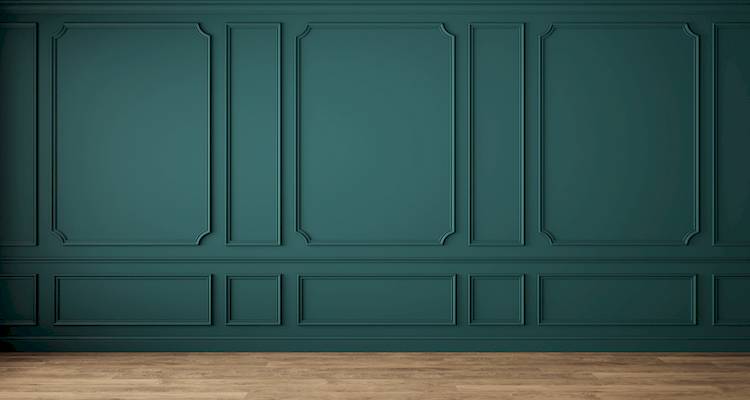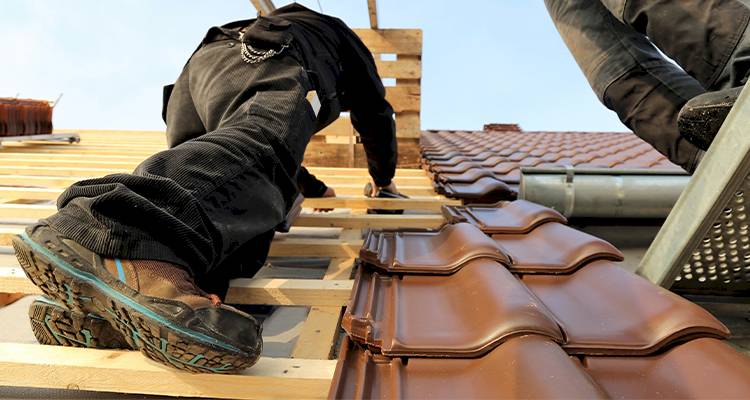Cost of Laying Turf
- The average cost of laying garden turf per m² is about £15.
- The job will usually take between 3 days to complete for a 100m² garden.
- A complete breakdown of turf costs, including the different types of turf available.
- How long turf installation takes, the installation steps, as well as the best time to lay turf in the UK.
- How to find and hire turf layers near you.
Want to find out lawn turf cost per m²?
The cost of laying turf can vary depending on what type of turf grass you choose, how large your garden is, and where your home is within the country.
To give you a rough idea, in terms of laying turf per m², it will typically cost around £15 per m².
Already got your plans set and just want a quote from a local turf layer?
MyJobQuote has a range of turf layers near you, ready to give you a free, no obligation quote!
Prefer to learn more about turf prices first?
Carry on reading below:

£15
Table of Contents
- How Much to Turf a Garden?
- How Much Does Turf Installation Cost?
- How Much Is Turf?
- Additional Costs of Laying Turf
- What Impacts the Cost of Laying Turf?
- Can I Lay Turf Myself?
- Alternatives to Turf
- Benefits of Laying Turf
- Garden Turf Removal Cost
- Checklist: Hiring a Garden Turf Installer in the UK
- Sources
How Much to Turf a Garden?
Looking for turf prices?
If you’re looking to turf your garden and want to work out a rough budget, there are several variables you’ll need to consider.
To turf a small 50m² garden, you're looking at prices between £120 to £1,250.
The larger the area, the higher the cost, so medium gardens of 250m² can cost anywhere between £600 to £6,250, depending on the type of turf you choose.
Large gardens of 450m² can cost between £1,080 to £11,250.

To find out how much turf you need, you'll need to know how big the area is that you want to turf. If your garden is an exact square, 10 x 10m, then you’ll need 100m² of turf.
But what about other sizes? Here's how to calculate the amount of turf you need:
- To calculate the area of a roughly square or rectangular garden, multiply the width in metres by the length in metres.
- To calculate the area of a triangle, you multiply the length of one side by the length of the distance to the point on the line perpendicular to it. Then, divide your answer by 2.
Most people will have a much more oddly shaped garden, and will want to add a few extra metres of turf in case of cutting mistakes and mismeasurements. If your garden is hard to measure, you’re better over-guessing quantities than under.
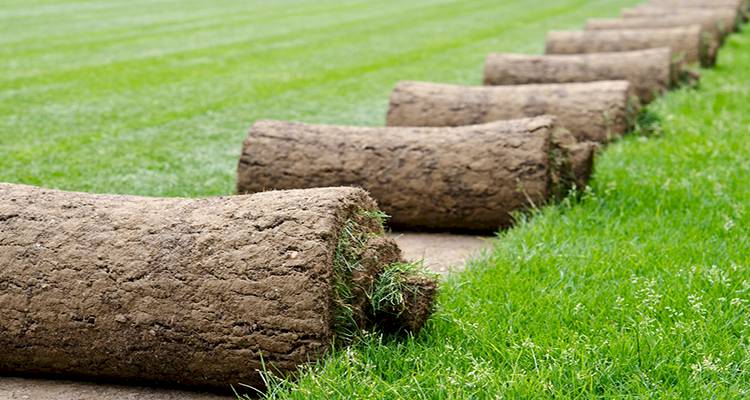
The type of turf you choose will affect your overall turf installation costs, which we'll cover in the next section. The location of your property shouldn’t affect how much you pay for turf, as many of the best types of turf are available online with standard delivery rates. However, in some locations, you may be able to get a different type and pay a different price at a local garden centre or DIY store.
Lastly, you will pay different prices for your contractors, but £150 to £200 per day is a good average to work from.
Do you always need to add topsoil when laying new turf down? Or is it only when you need to level out the area?
Garden Turf Prices
Lawn turf prices will make an enormous difference to your overall turf installation costs. Here's what you can expect to pay:
| Garden Size | Budget turf (£2.40 p/m²) | Average turf (£3.50 p/m²) | Luxury turf (£4.70 p/m²) | Meadow turf (£25 p/m²) |
|---|---|---|---|---|
| Small garden – 50m² | £120 | £175 | £235 | £1,250 |
| Medium garden – 250m² | £600 | £875 | £1,175 | £6,250 |
| Large garden – 450m² | £1,080 | £1,575 | £2,115 | £11,250 |
You can expect to pay anywhere between £2.40 to £6.90 per m² for budget, average, or luxury turf. This means that 100m² will cost you between £240 and £690.
The difference in cost is due to the composition of the grass – and the composition you choose will depend on your requirements. A hardwearing turf is a great choice for gardens with rough and tumble children, energetic dogs and sporty families.
However, someone who wants the beauty of a perfect lawn will want a more luxurious composition. A good quality grass will be a blend of meadow grass, fescue grass and ryegrass.
You can also get meadow turf, which is full of natural wild seed. If you wish to incorporate this into your garden, you can expect to pay about £25 per m².
How Much Does Turf Installation Cost?
Now, let's take a look at labour costs and timescales.
You can expect to pay between £150 to £200 per day for turf laying specialists.
Laying the turf itself is the shortest part of the job – your main time is going to be spent preparing the soil. This preparation will include removing any existing surface, digging down to a suitable level, preparing the existing soil and adding topsoil or soil improver before laying the turf.
Many turf specialists recommend you actually leave it for up to 6 weeks for the soil to settle between doing the preparation and laying the turf.
Depending on the depth you dig down, the quality of your soil (and whether you need to add fresh, topsoil or soil improver), how much you need to rotavate or rake, and how long you leave the soil to settle before laying the turf, as well as your ground area, you could be looking at huge variances in your labour time and costs.
As a very rough guide, you should allow around 60 minutes per m² (without including time for the soil to settle, which could add up to 6 weeks to your project time) to prepare your soil adequately (note: this is by hand, not using a digger).
With all the soil preparation already done and with everything in place, a single contractor can lay around 100m² turf per day. This means you’re looking at a rough time of 65 minutes per m², or 100m² in just around a week.
In terms of labour, a professional turf layer will charge a higher rate for their services, but you will get the most knowledgeable people who will likely have encountered every scenario, meaning your particular garden should be within their skillset.
Alternatively, you can go with a general landscape gardener, who will also have extensive knowledge of soil types, turf properties, ground issues etc. An added bonus of a landscape gardener is that they may be able to offer advice on better ways of laying out your turf area to complement your garden.
Finally, you can hire a trainee labourer, who will come at a lower cost, but with lower experience.
| Labourer Type | Knowledge of Turf / Turf-laying | Complementary Knowledge | Cost per day |
|---|---|---|---|
| Specialist Turf-layer | High | Medium | £150 - £200 |
| Landscape Gardener | Medium-High | Medium-High | £110 - £180 |
| Trainee Labourer | Medium – Low | Medium – Low | £75 - £100 |
How Much Is Turf?
Let's take a look at supply costs alone now:
There are two costs to bear in mind when purchasing turf: the price of the turf itself, and the cost of delivery. In respect of delivery, there really isn’t an average you can work from. It absolutely depends on the quantity and the retailer.
If you’re buying in person from a standard DIY/garden shop, you will have no delivery charges, though there are logistical complications if you have a large garden and require a large quantity of turf. Buying individual pieces of turf from a shop does work out cheaper, though, if you’re only getting a small amount.
Just bear in mind that the turf will dry out the longer it’s on display, so ask your retailer when their turf deliveries arrive and aim to collect yours on the same day.
If you’re buying from an online DIY/garden retailer, there is often a minimum order amount and a £20 to £30 delivery fee, so this doesn’t make financial sense for small quantities of turf.
An alternative would be an online turf specialist – they will deliver the turf to you as fresh as possible (often cut to order and with quick delivery) and will have a range of turf types.
Many have a minimum order quantity, but this can be as low as 10m². With this method, there will usually be a per m² delivery charge, of £1 to £2.50, with the lower delivery charge being applied to higher quantities of turf.
The second factor to consider is the turf type. There are lots of varieties of grass, and they are grown in combination with each other to create different textures and looks. However, these broadly fit into two categories.
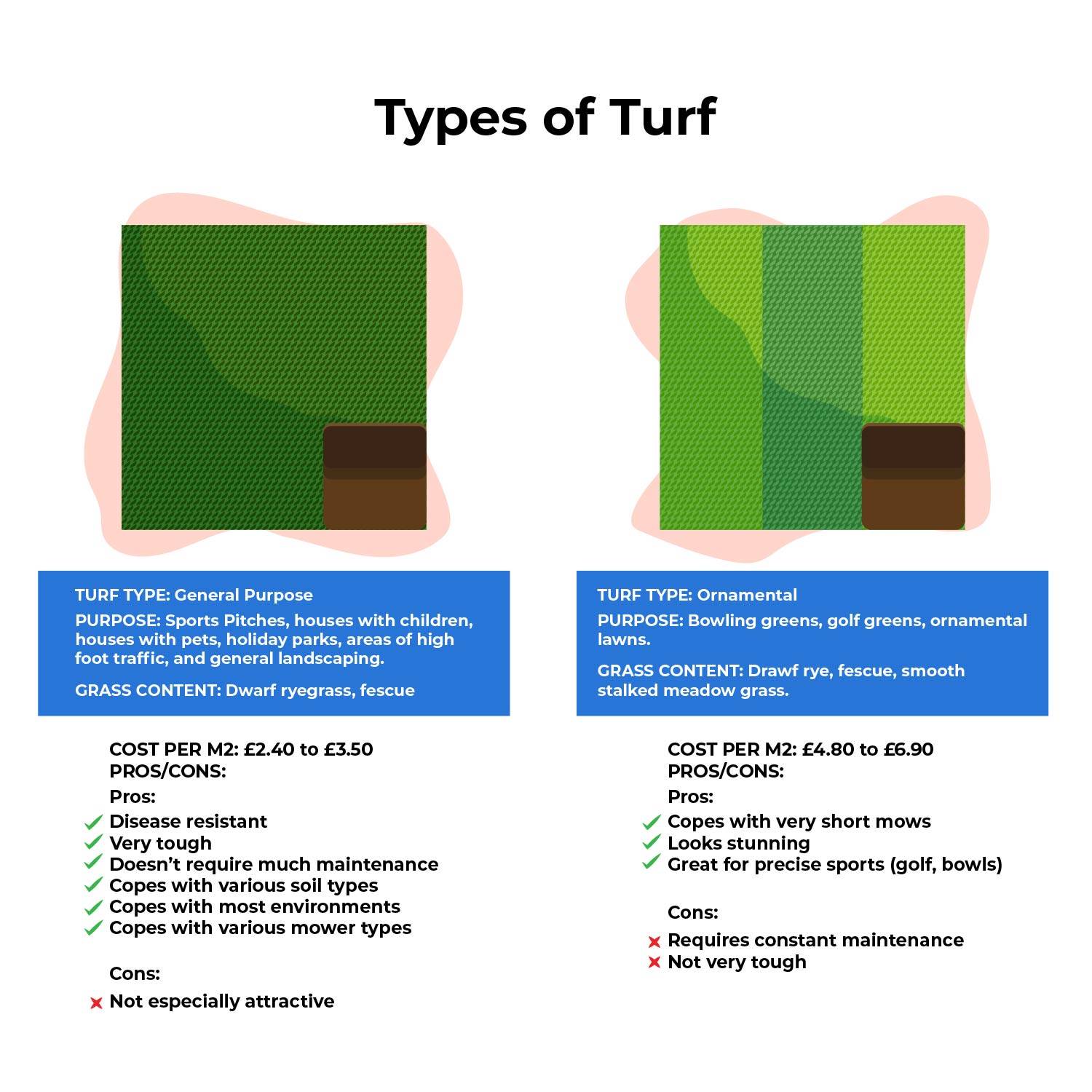
You should bear in mind when you buy turf that it should come from a reputable seller who works to the Turf Growers Association standard (TGA).
Additional Costs of Laying Turf
If you're planning on laying the turf yourself, there are additional costs you should be aware of. Unless your soil is in tip-top condition, you'd be advised to purchase some high-quality topsoil to give your grass the best start possible.
Topsoil costs between £45 and £135 per m³, depending on the quality and quantity you buy. If you plan on growing a strong lawn which will look beautiful and last for years, higher-quality topsoil will give you a much better chance of achieving that.
If you're looking to cut down on the time required for this however, you may want to hire a digger to remove the existing turf/weeds/soil, as well as bring the new topsoil across to the site.
To hire a small, easily manoeuvrable digger, it will cost you around £200 for the first day, and £50 to £75 for each additional day, but it will work out cheaper overall if you need to hire it for an entire week.
Before you hire a digger, do measure the access areas to your lawn to ensure you don’t damage narrow passageways, or sheds etc.
While you're setting up your new lawn, it can be an ideal opportunity to get other work done. Once you have paid for high-quality topsoil and beautiful turf, then hired a landscaper or spent weeks of your time, you won't want heavy machinery or workmen damaging the grass – or worse still, digging up your new lawn to locate pipes and drainage!
The cost of a new patio is around £1,200, and can transform your outdoor space while providing a space to entertain in the warmer months.
You may want to upgrade your outdoor structures and add in a summerhouse. New summerhouses cost around £3,000, and will give your garden another dimension to draw the eye to.
If you're considering garden water features, a new pond costs between £500 to £1,000, and provides both aesthetic appeal and a natural habitat for aquatic creatures.
As well as future work on the garden, you may also wish to consider whether you will want to do future work on your house. The following jobs are all likely to require either access via your lawn or damage to it:
- Double glazing costs £200 per medium-sized window.
- External rendering costs £5,000 for an average-sized house.
- House extensions cost £40,000.
- Conservatories cost £15,000.
- Roofing repairs cost £650.
With both house and garden alterations, it is best to complete all major work before laying your new turf – not only will this allow it the required number of weeks to root in without being walked on, but it will also mean it is damaged as little as possible, meaning you get the strongest and best-looking lawn for your money.
What Impacts the Cost of Laying Turf?
Laying turf is like any other home and garden project – the amount you pay can fluctuate wildly. But, you can potentially work out a rough budget if you calculate the cost considering these key factors:
Size of Garden
A 1,000m² garden will require a lot more turf than a 50m² garden. But, that’s not to say it will always cost more to have a larger garden – considering the other factors below will make a big difference.
Type of Turf
Your turf requirements will hugely affect the per metre cost of your turf. If you’re looking for quick coverage with no specific requirements, you can pay a lot less than if you want a turf that has a function, such as an ornamental turf or the very high-maintenance fine turf used for golf greens and bowling greens.
Quality of Turf
It is the same with quality - a hardwearing, disease-resistant basic lawn will cost more than less well-bred basic lawn turf. A high-quality ornamental turf might cost you up to £6.90 per m², whereas at the other end of the scale, you may be able to get a basic off-the-shelf turf for around £2.40 per m²
Property Location and Ease of Access
There are two key variables here. The first is the regional location – a more affluent area will likely charge more for turf than elsewhere, as well as increasing the cost of skilled labour.
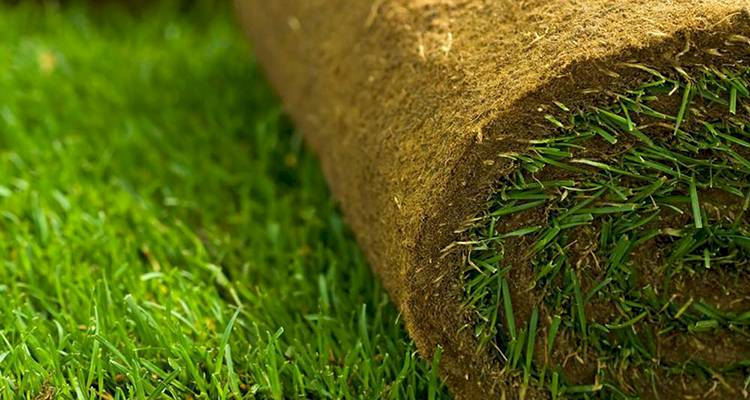
The second is the access to the location – locating the right kind of turf and then transporting it to a cottage on the side of a mountain in Wales will cost substantially more than locating and transporting it to a property in the suburbs of a city, where transport infrastructure and turf-growers are likely to be more easily accessible.
Another definition of ease of access can be how easy it is to get from the nearest road to your garden – narrow country lanes, as well as narrow passages beside the garage, will all contribute to either your delivery cost or the time (and therefore cost) of your landscaper.
Cost of Landscaper
Research of landscaping costs across the UK shows that the daily rate can fluctuate between £100 and £400, or £15 to £50 per hour.
And this isn’t necessarily just your commonplace London mark-up – more affluent areas known for their greenery, such as Surrey or Cheltenham, are looking for a landscaper with more skills and experience, which when added to the higher living expenses of those areas makes for a big variance in cost.
On the basis that a landscape gardener would lay on average 33m² of turf per day, including all the preparation, that means that 1m² of turf will cost approximately £3 to £13, with standard ground preparation.
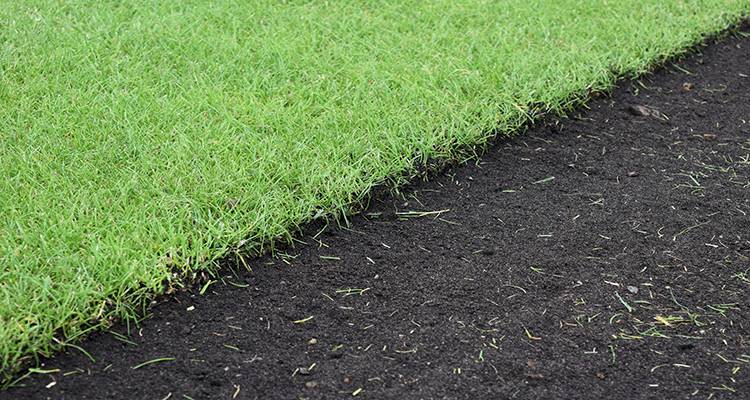
State of Your Current Garden
All the prices are based on the assumption that your existing garden is either already grass, or another type of blank canvas, which just needs digging, preparing, and then laying.
Your costs will go up with every additional challenge you provide to your landscaper: high/intrusive/dense weeds, concrete, existing structures for removal (old sheds, empty ponds etc.), lots of trees, poor soil, etc.
These will not only increase the number of days your landscaper requires to do the work but may also result in the hire of more labourers and potentially mechanical equipment as well.
I have a very small front garden. I would like it sorted out, as it's in a fairly bad shape, so I guess dug out and turned over with new turf. I was just quoted £560 - is this the average?
Timeline
How quickly do you want the work done? Someone who is happy to let a single landscaper work on their garden over the course of two weeks will pay considerably less than someone who wants four landscapers to work in tandem and finish the job in three days.
A longer deadline will save you money in the long term.
How Much Work You’re Prepared To Do
Finally, the more work you put into the preparation and turf-laying, the less it will cost you. If you’re willing to put in the work yourself and need only purchase the turf, topsoil and any equipment, you will save thousands of pounds, but at the cost of your free time.
Even a little ground preparation can save you hundreds – dismantling the old shed, digging up your existing lawn, and lifting and removing old paving will mean your landscaper spends less time on your project, saving you money.
| Garden Size | Quantity of turf | Type and quality of turf (cost per m²) | Total landscaper cost (approx.) | Total |
|---|---|---|---|---|
| Large | 1,000m² | £2,400 - £6,900 | £3,000 - £12,000 | £5,400 - £18,900 |
| Medium | 400m² | £960 - £2,760 | £1,200 - £4,850 | £2,160 - £7,610 |
| Small | 75m² | £180 - £518 | £300 - £1,200 | £480 - £1,718 |
Can I Lay Turf Myself?
Laying your own turf is a fantastic idea if you’re looking to save money. The risk of injury is fairly low, and with a simple lawn, you can achieve great results with a small budget.
But, this needs to be weighed up against the quality of the outcome you want, the timeframe, and the existing issues you’ll have to overcome.
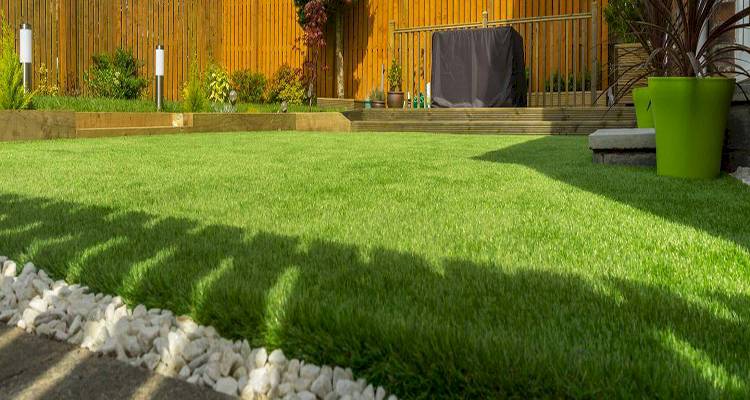
If you’re good at research and/or happy to get advice from professionals, you should be able to work out what kind of turf you want fairly easily, and further research will usually find a retailer who can deliver it at a price you’re happy with.
You can also find out how to lay turf by following online guides, videos, or getting help from friends.
What you can’t learn from a book or a blog is experience, and this is what you’re paying a professional for.
A video can’t examine your soil and determine how best to improve its quality, and a friend won’t be able to guide you on turfing around surface tree roots. If you have any of these, or similar issues, you will be better at least consulting a professional before undertaking the work.
If you don’t need to hire any special machinery, turf laying is a safe job – so long as there are no electrical cables or water pipes near the surface of your existing garden. A digger, pneumatic drill or turf cutter requires a bit more skill and precaution, but safety gear and care will make these much safer.
There are no legal requirements, inspections or guidelines when laying your lawn, so it is up to you to make it level, even and safe.
But, doing sufficient preparation, purchasing the right type of lawn, and allowing enough time to complete the job carefully will give you the best chance of doing a great job without needing to hire a professional.
I had new turf laid in September and first cut it in November when it was about a foot high. Since then, it has become patchy, with areas where the grass appears pressed down and isn’t growing. How can I fix this, and what would it cost?
Alternatives to Turf
Not everyone wants a lawn in their garden. The idea of the ongoing work that even a small lawn can entail puts many people off, and some people would rather fix a permanent structure instead of a living plant. So what are the alternatives?
Decking
This is a flexible outdoor flooring type which doesn’t need to be used just for flooring. Decking comes in wooden planks, usually smooth on one side and grooved on the other – you can lay it whichever way you like, although the grooved side tends to add more grip.
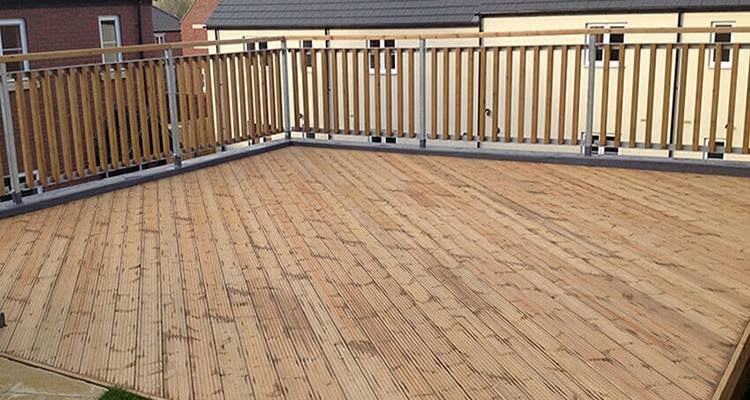
You can lay decking directly onto the floor (or on a bed of gravel), though the more contact it has with water, the sooner it will begin to rot. Most people lay decking onto either a concrete block-based (e.g. breeze blocks) or onto a specially made wooden frame. Both of these raise the level of the decking, keeping it drier and giving it a longer life.
There are six common types of decking board:
- Pressure-treated fir, protected by anti-rot and pesticide agents - This is low cost and can last for decades so long as it is regularly stained or sealed (every year or two).
- Cedar – Heartwood cedar (not sapwood cedar, which rots very quickly) will live for 15 – 20 years if annually sealed. This wood is beautiful and inexpensive.
- Redwood – This is lightweight, strong, rot-resistant and easy for labourers to work with. Try to obtain high-grade redwood containing little sapwood, which is prone to rapid deterioration when outside.
- Vinyl – Recently available, PVC (polyvinyl chloride) decking is nearly maintenance-free and often comes with a 25-year warranty. There are also many colours to choose from.
- Composite - This is a mixture of recycled polyethylene and wood fibre, and comes in many colours and textures. You can also get it in shape so it can be laid in a pattern, and it’s very low maintenance: a good clean every three or four years will remove any mould living in the wood, and any good quality composite will come with a 25-year warranty.
- Ipe – This is a very hard wood that comes from South America – it is so hard, in fact, that installation requires a lot of work, and this can increase your costs if you’re paying for a builder to construct it.
Ipe needs sealing every year, so there is a small amount of maintenance, but it will then last for 25 years or even more. The cost of this wood will fluctuate as it needs to be imported, but beware of cheaper versions, which may have been provided in a non-sustainable way.
| Fir | Cedar | Redwood | Vinyl | Composite | Ipe | |
|---|---|---|---|---|---|---|
| Cost (per m²) (approx)* |
£25.50 | £40.50 | £83.50 | £80.75 – £102.25 | £84.00 | £129 |
*This does not include any labour, such as installation charges.
Artificial Grass
This used to look and feel like an area of hard plastic spikes, which were unappealing on the eye and painful underfoot. Artificial grass has come a long way, and many types are now very close to natural grass.
As with lawn turf, artificial grass comes in different qualities and with different properties – so before you start your research, ensure you know how hard wearing it needs to be, how short you want it, what your budget is, and how easy you want the installation to be.
The most basic artificial grass costs around £10 per m².
At the other end of the scale, premium grass, which will look beautiful and may even come with a guarantee, can cost around £27 per m². Hovering in the middle at £22 is the mid-range grass, which can vary wildly in quality and how realistic they are, so always get samples.
| Garden Size | Quantity of turf | Budget artificial grass | Mid-range artificial grass | Premium artificial grass |
|---|---|---|---|---|
| Large | 1,000m² | £10,000 | £22,000 | £270,000 |
| Medium | 400m² | £4,000 | £8,800 | £10,800 |
| Small | 75m² | £750 | £1,650 | £2,025 |
Patio
Another alternative to grass is a patio. This is much easier to maintain, simple to clean, and if laid well, it will remain solid, level and weed-free for many years.
Here are the key benefits to having a patio:
- It can increase the value of your home – outdoor entertaining areas are very appealing to potential buyers and may add value, or at least kerb-appeal, to your house.
- It can increase your living space, giving the family an extra room in the garden. With some furniture, cushions and lighting, a patio can become very comfortable outside living or dining.
- With the addition of a parasol or sail, a patio can provide a private enclosed space in the outdoors – all the fresh air, but protection from the heat of the overhead sun.
- Patios are low maintenance – you can clean them with a pressure washer, and if you buy high-quality slabs, they will be unlikely to fade, crack or crumble.
Patios are hugely variable in cost, as the size of the patio, quality of finish, type of surface (concrete, brick, paving), size of brick/slab, and design will all adjust your expenditure. You can go for a basic concrete patio, which might cost as little as £30 per m², and will provide a highly durable and low-maintenance patio.
At the other end of the scale, a well-designed slab patio might cost closer to £75 per m², but will give you a more refined look and more options in design.
Gravel/Slate/Bark
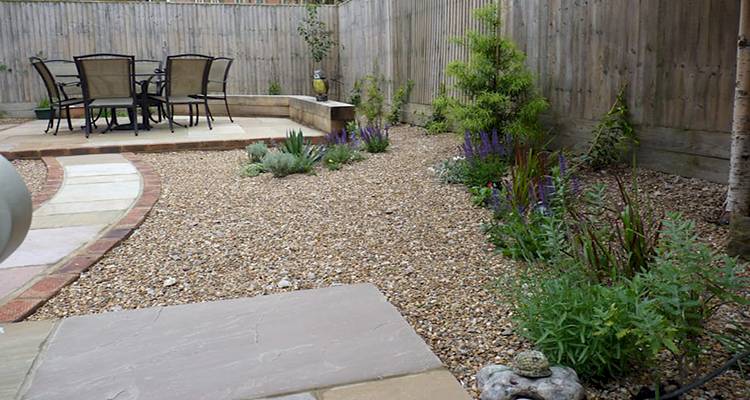
A gravel, slate or bark area in your garden can give a more rustic feel than a neat deck or patio. The idea of using these is to have a softer outline, and you can even plant greenery, which blurs the edge even more.
With each option, you will need to prepare a flat area for it – this will then need to be covered with a strong weed membrane to keep unwanted plants from growing through.
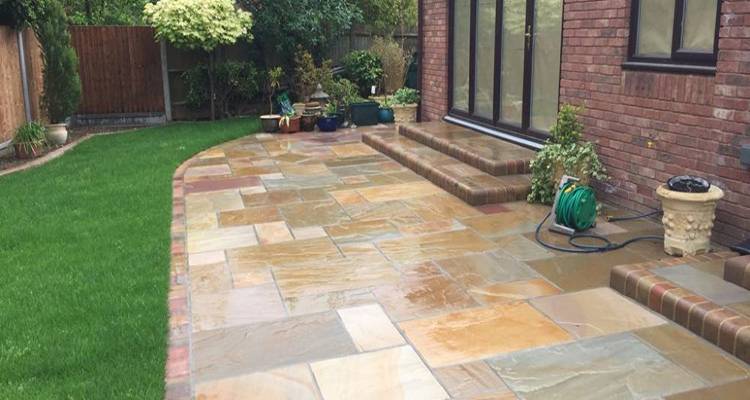
All of these are usually bought in a dumpy bag, which holds around one cubic metre of whatever you’ve purchased. Generally, you want to have your gravel and slate at a depth of 5cm to 10cm in your garden, whereas bark needs laying at 10cm to 15cm, as this will compact more over time.
To work out the amount of each you will need, multiply the required depth by the square metre area to be covered.
| Small Garden (75m²) | Medium Garden (400m²) | Large Garden (1,000m²) | |
|---|---|---|---|
| Gravel – 10cm depth | £260 - £1,800 | £1,400 - £9,600 | £3,500 - £24,000 |
| Bark – 15cm depth | £300 – £1,125 | £1,600 - £6,000 | £4,000 - £15,000 |
| Slate – 10cm depth | £560 - £975 | £3,000 - £5,200 | £7,500 - £13,000 |
Gravel can cost as little as £35 per m³ for a basic shingle or limestone chippings. At the other end of the scale, a rose decorative gravel will cost £240 per m³.
Bark will cost between £40 and £150 per m³, the difference in cost being in the type of wood and the look of the chippings.
Slate is between £75 and £130 per m³. You can get variations in the size of the pieces as well as variances in colour, such as a blue, green or purple tone.
How do I go about levelling a garden to have it paved and turfed?
Benefits of Laying Turf
Adding turf is likely to add value to your home – your average family will have children or pets or both, so an area of grass in your garden is an ideal playing area for them.
Grass also adds an area to relax and enjoy being outside. Plus, a particularly well-kept, lush area of lawn is really appealing to potential buyers, who will pay much more for a house with a lawn.
Turf is inexpensive – compared to the cost of artificial grass, a patio, decking, or even a layer of gravel, turf turns out to be much more cost-effective, and the larger the area you’re covering, the more cost-effective it becomes.
Turf is a great natural way to make a living area on your land. Grass is a living, growing plant, and can help remove dust and pollutants from the air, much as many houseplants do inside your home.
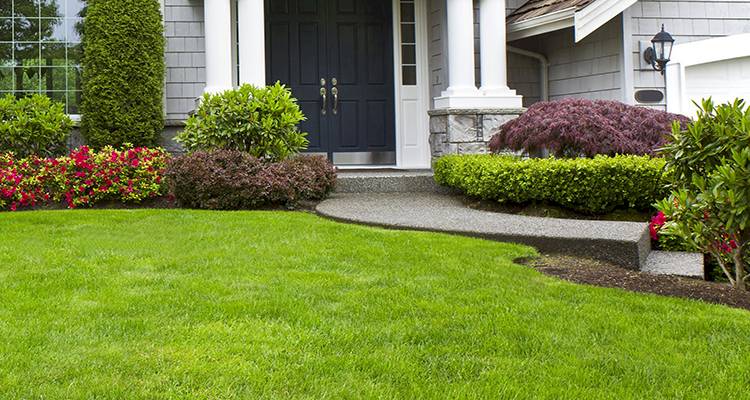
Turf makes an impact quickly. One day, you have an area of plain soil, and the next, you have an area of lawn. Compared to re-seeding a lawn, which can have mixed results at best, putting turf down ensures even coverage, the same type of grass, the same colour of grass, and a very speedy result.
Turf is easy to lay and will last well so long as you do adequate preparation and really look after it for the first two months.
And finally, it allows you to pick the kind of grass which is going to fit your life, your house and your lifestyle. If you have an existing lawn which is rough and hardwearing, but you’d rather have something more aesthetically pleasing and lush, adding carefully chosen turf will give you that result really quickly.
Garden Turf Removal Cost
Knowing how to remove turf is another key skill which may well come in handy. If you have a patchy lawn already, you may wish to replace the existing grass with a new lawn.
Additionally, if you have a garden completely covered in grass, but you’re looking to remove some to make way for flowerbeds or seating areas, you’ll need to know how to remove it.
Removing small quantities of turf is a job you can do without help and at no cost. A garden spade, slid a couple of inches underneath the grass, will take off that top layer of turf without too much damage to the underlying soil.
If you have a larger area, you can hire a turf-cutter from your local tool hire shop for £50 to £100 for a day, and this will slice the top layer of grass off your lawn in big long strips, allowing you to roll them up for disposal.
There are a few options when it comes to disposing of old turf, each with its own pros and cons:
- It will make great compost, so long as it hasn’t been treated with a weed-killer. Whether you have an existing compost heap or not, just turn the pieces of turf over, grass side down, and stack them into a pile in a sunny corner of the garden. Over a couple of years, the grass will break down and provide a rich compost for your garden.
- You may be able to dispose of the turf via your local council – check your local council’s website for more information.
- You could recycle the grass and use it to add a feature to your lawn. A pile of turf, or soil with turf laid on top, will make a great raised bank in your garden, perfect for lying against in the sunshine. You could also make a living roof for your shed, though this needs to be done with care, so you don’t end up with a soggy and collapsed shed.
- Hire a skip, or someone to take the turf away – a skip will cost around £100 for a small size, and hiring an individual to take the turf away will cost a similar amount.
- A cheaper alternative may be to have the entire job completed by a landscaper – not only will you get a high-quality job done by a professional, but you will save the cost of hiring a turf-cutter, a digger and maybe a rotavator, and they will usually take the rubbish and old turf with them at the end of the job.
Do I need to improve the drainage of my clay soil before laying turf?
Checklist: Hiring a Garden Turf Installer in the UK
If you’ve decided that you’d rather leave the job to the professionals, there are a few things you should look into before you hire a landscaper or turf installer.
- There are no qualifications required to install turf, so you can only judge the quality of your labourer’s work by what they’ve done previously. Ask to see pictures of their past work, and get comments from previous customers to find out how well the job was done.
- Do they have any linked qualifications, such as horticultural degrees or landscaping courses? While not directly about turf-laying, they give a lot of information and context about soil, grass, etc., which would give that individual a big advantage.
- How much experience does your turf installer have? Are they new to this role, or have they been doing it for a while? Did they work as an apprentice or assist more experienced landscapers and learn on the job?
- What do they include in their work? Would they pay for all equipment/diggers/turf-cutters/skips, etc., and include it in their price, or would they add that to the bill?
- Are they just turf layers, or could they offer guidance on other work you’re doing to the garden? Are they experienced enough to offer suggestions?
FAQs
What Is the Best Time to Lay Turf?
When to Cut New Turf?
How Often to Water New Turf?
New turf needs to remain moist for at least the first ten days, and preferably two weeks. So if you’re laying your turf in autumn and it’s neither hot nor dry, you may only need to water every other day.
But in warmer weather or any dry spell, you need to ensure you fully soak your turf every evening and top it up in the daytime if you find parts of your turf are coming away from the ground, curling or going brown at the edges.
When Can I Walk On My New Turf?
What is Turf?
How Do I Ensure My New Turf Grows Well?
The best method here is to be patient. Prepare your ground really well before you lay the turf, and some experts even suggest leaving your prepared soil for up to six weeks before you add the turf to let it settle and even out.
Lay the turf carefully, then leave it as long as possible before you walk on it. Ensure you keep it well watered, and once it has bedded in try to keep it weed-free, and add fertiliser to it every 4 to 6 weeks over the growing season.
Sources
https://www.gov.uk/garden-waste-disposal
https://www.fieldcompost.co.uk/store/products/high-quality-planting-topsoil





